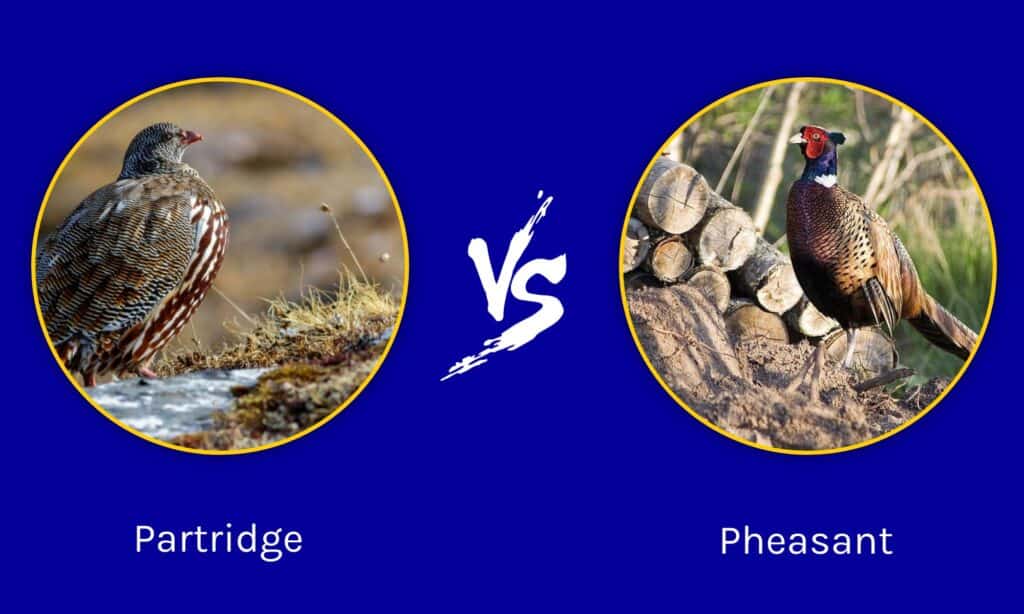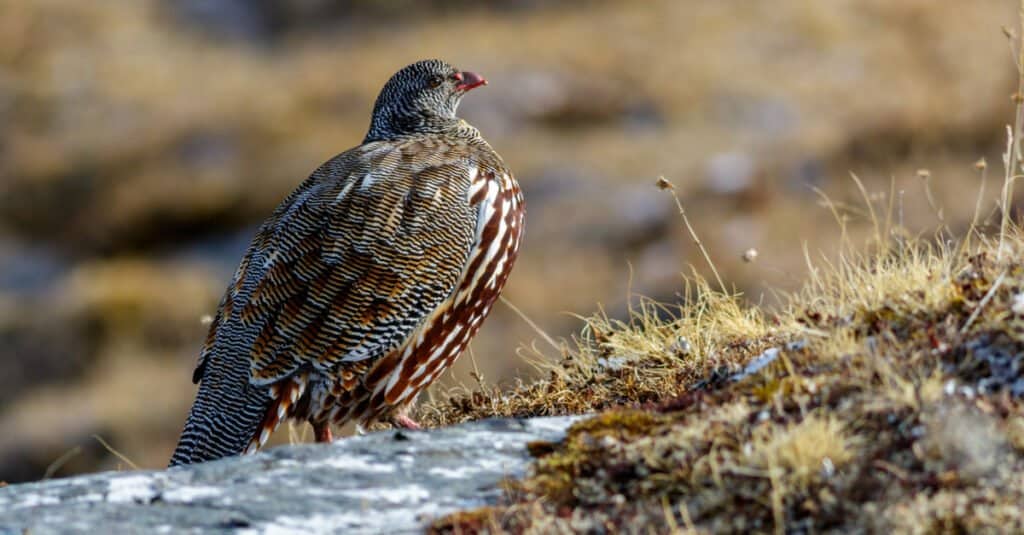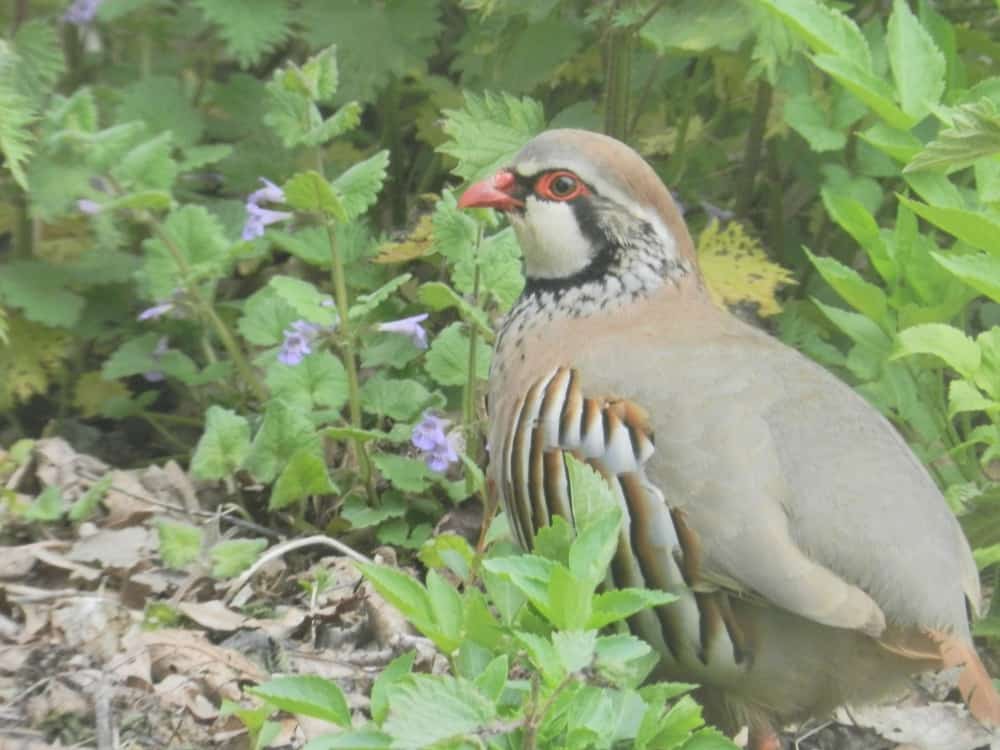The partridge and the pheasant are some of the most common game birds in the world, but few besides hunters know their differences! These two birds are incredibly closely related and represent larger groups of various birds with similar features. Today, we are going to take a look at both the partridge and the pheasant and see what makes them unique. Let’s explore the partridge vs the pheasant and their differences.
Comparing a Partridge and a Pheasant

| Partridge | Pheasant | |
|---|---|---|
| Taxonomy | Family: Phasianidae Subfamilies: Rollulinae, Phasianinae, and Pavoninae | Family: Phasianidae Subfamilies: Phasianinae and Pavoninae |
| Size | Weight: ~.75 lbs Height: 12 in | Weight: 1-7 lbs Height: 23-35 in |
| Color | Depends on the species, but usually brown and grey | Gold or copper plumage. Green or purple neck with a red head. |
| Tail | Little to no visible tail | Long, distinct tail |
| As a game bird | Various species hunted worldwide | Common pheasant (ring-necked pheasant) is most often hunted |
The Key Differences Between a Partridge and a Pheasant
The key differences between a partridge and a pheasant are size, color, and tail length.
One of the most confusing things about game birds is how similar they can be. In the case of the partridge and the pheasant, this is complicated by the fact that they are closely related. Both birds are members of the Phasianidae family but are further broken into subfamilies where the individual species are different from one another.
The names of both birds are quite deceiving as well. Although most people have specific birds in mind when imagining the words “partridge” or “pheasant,” they are actually large groups of birds with dozens of distinct species within. Generally, the most commonly seen bird in the region is what people refer to when they call a bird a partridge or a pheasant. In North America, the most common partridge is the gray partridge, while the most common pheasant is the common pheasant.
Let’s take a closer look at both birds and compare some of their similarities and differences.
Partridge vs Pheasant: Taxonomy

Partridges belong to the Phasianidae family, which also includes pheasants.
©Bhavesh Rathod India/Shutterstock.com
To understand the difference between these two birds, an understanding of their scientific categorization is important.
The partridge belongs to the Phasianidae family. Members of the Phasianidae family are usually heavy birds that primarily live on the ground. Included in this family are pheasants, junglefowl, chickens, turkeys, Old World quail, and peafowl. As you can see, the partridge and the pheasant are both members of the family. The branching of the two groups begins one category lower, in the subfamily breakouts. Partridges belong to a few subfamilies, including Rollulinae, Phasianinae, and Pavoninae.
Pheasants, like partridges, belong to the Phasianidae family. Within that family, pheasants belong to two subfamilies, including Phasianinae and Pavoninae. Still, even within those specific groupings, birds are often referred to as pheasants, even though they are more closely related to turkeys or grouse. Generally, most people refer to the common pheasant when they talk about them.
Partridge vs Pheasant: Size

Pheasants are usually larger than most species of partridge.
©gary noon, CC BY-SA 2.0, via Wikimedia Commons – License
Although both are considered to be large, ground-dwelling birds, most species of partridge are smaller than the average pheasant. Still, there are some large species of partridge that are roughly the same size as the smaller species of pheasant. A gray partridge usually weighs less than a pound and is about 12 in tall (or long).
Pheasants are usually larger than partridges, with their long tails adding extra length to them as well. Still, the exact weight of a pheasant depends on the species. Across all species, the average weight is between 1-7 lbs, and the average length is between 23-35 in.
Partridge vs Pheasant: Color

Partridges are usually brown or gray.
©Millie Bond – Copyright A-Z Animals
Partridges are usually duller in color than pheasants. Most species of partridge are gray or brown and blend into brush and shrubbery quite well. Aside from their brown and gray colors, most partridges have a red or orange beak and a distinct eye mask of black.
Pheasants are well-known for their bright colors and displays. The common pheasant is gold with a vibrant blue-green neck and red eye mask. Other species are even more vibrant and can come in shades of gold, blue, red, orange, and more.
Partridge vs Pheasant: Tail

Pheasants usually have long, flowing tails.
©Maksym Gorpenyuk/Shutterstock.com
An easy way to tell a partridge and a pheasant apart is their tail. Partridges are squat birds with a short, stubby tail that doesn’t reach more than a few inches past their bodies.
Pheasants have long, distinct tails that often extend as long as their body length or more. They usually hold their tails close to the ground, making it one of the best ways to identify them.
Partridge vs Pheasant: As a Game Bird

Both species are incredibly popular game birds across the world.
©Elmira Yu/Shutterstock.com
Both species of birds are important game birds in the hunting community. In North America, the gray partridge is the most commonly hunted bird, although the red-legged partridge is also quite common. Both are bred in game farms and released yearly. Neither species, however, is native to the US and was brought over from Europe for the purpose of hunting.
The pheasant only has one commonly hunted species, the common pheasant. Originally native to Eurasia, the common pheasant is now a common game bird across much of the United States. It is also bred in game farms and released each year to increase hunting populations.
The photo featured at the top of this post is © iStock.com/luamduan
Thank you for reading! Have some feedback for us? Contact the AZ Animals editorial team.







